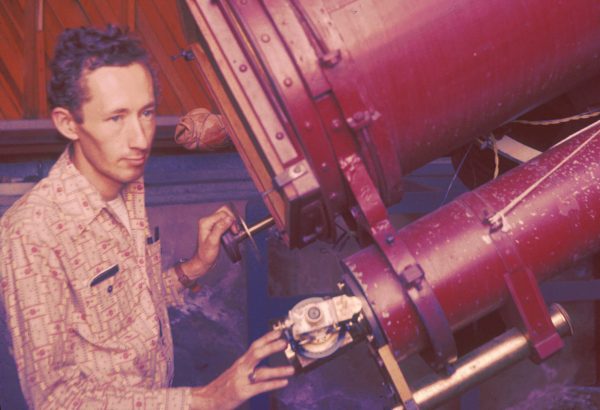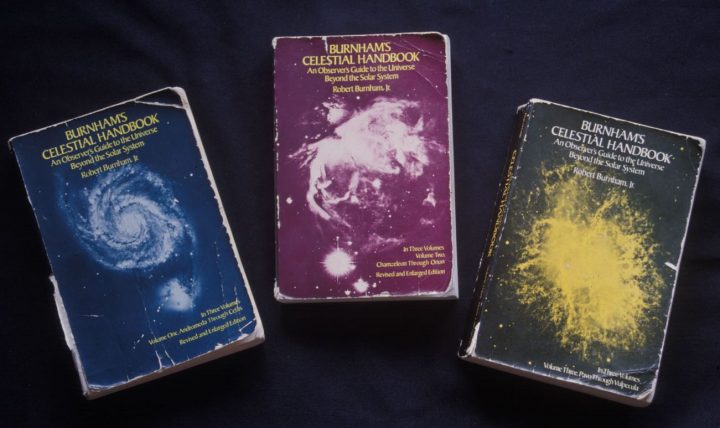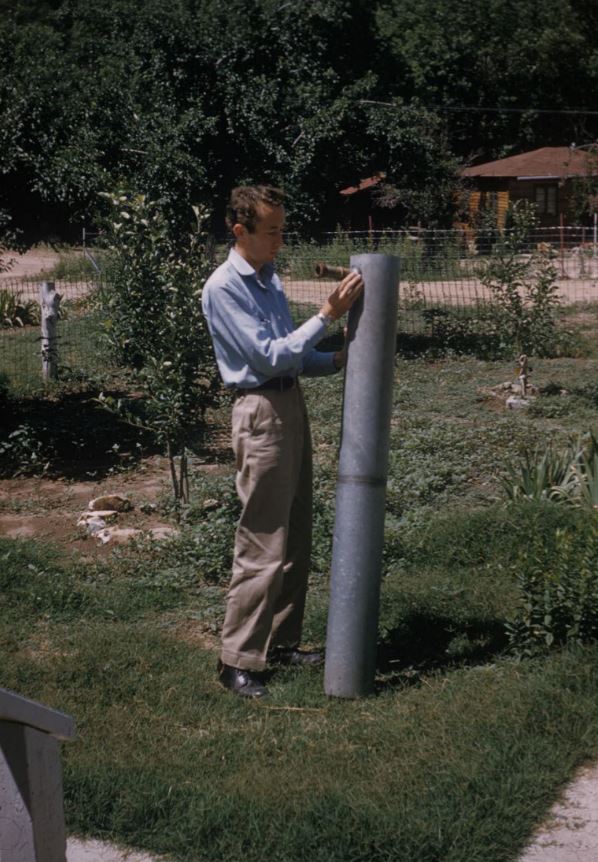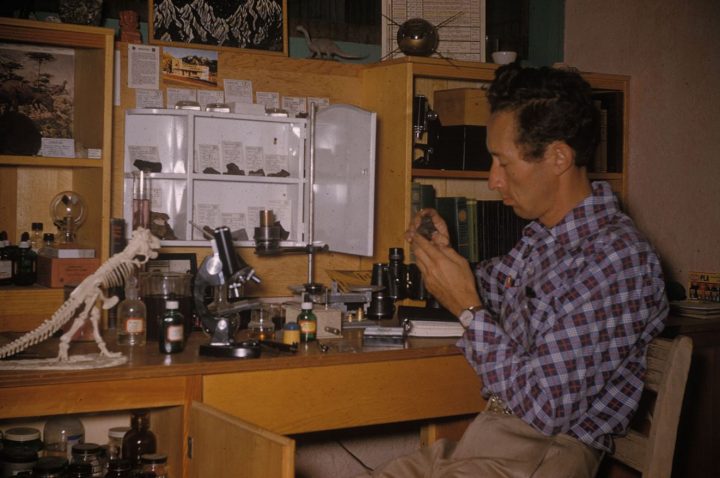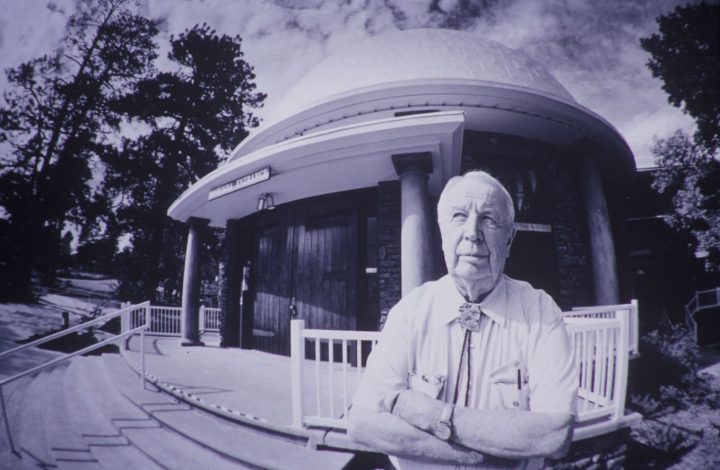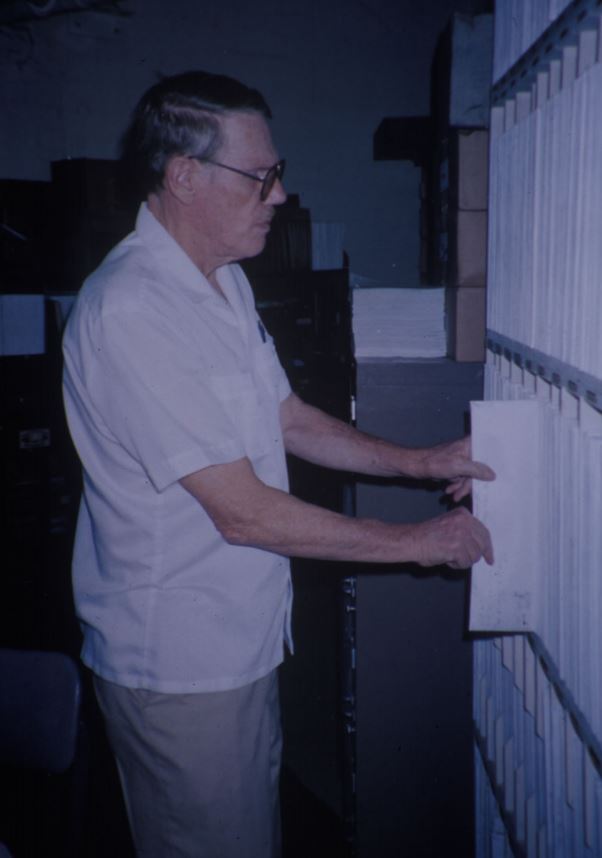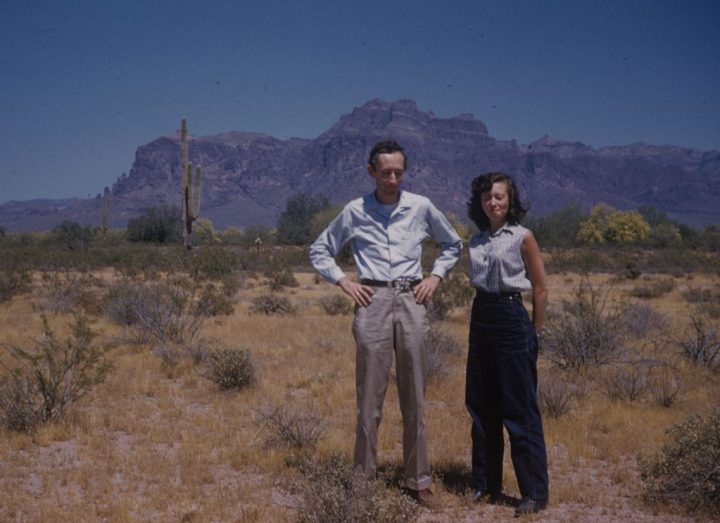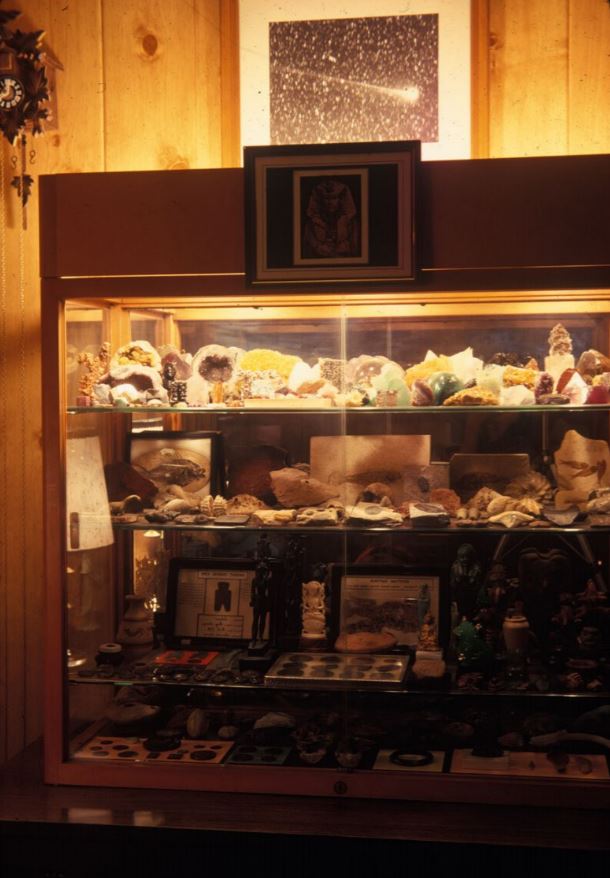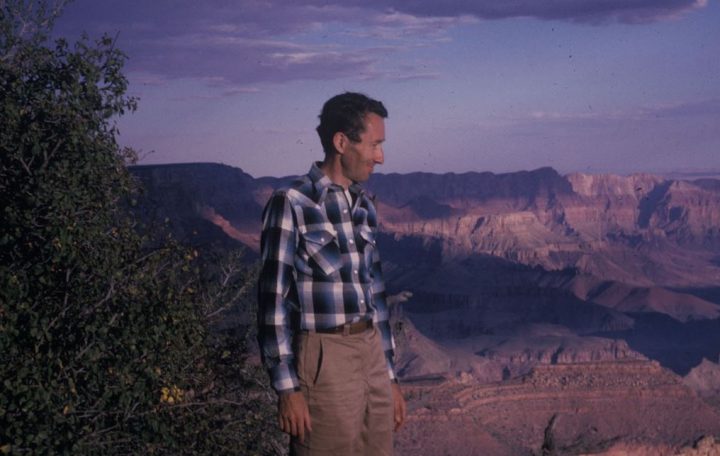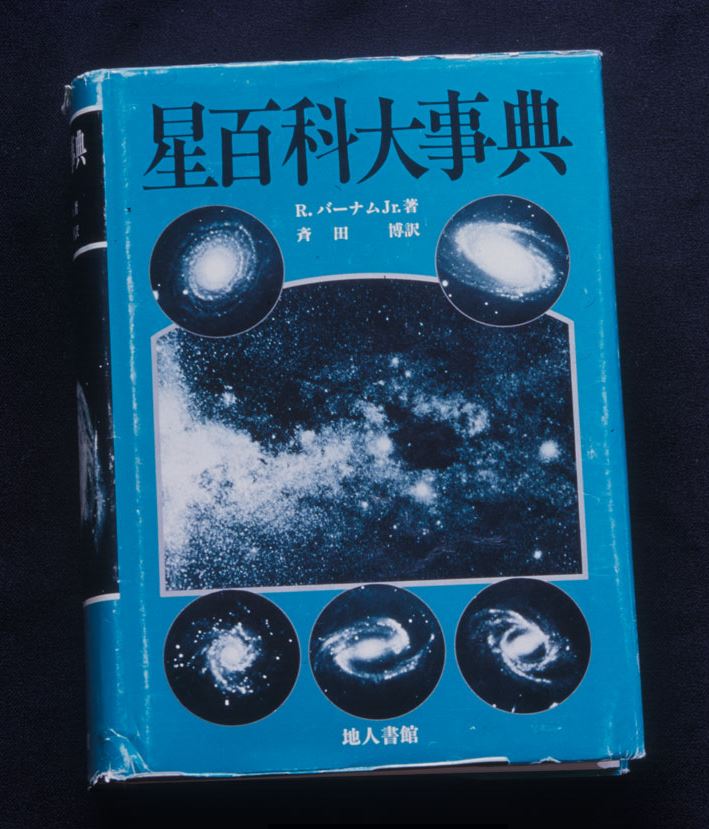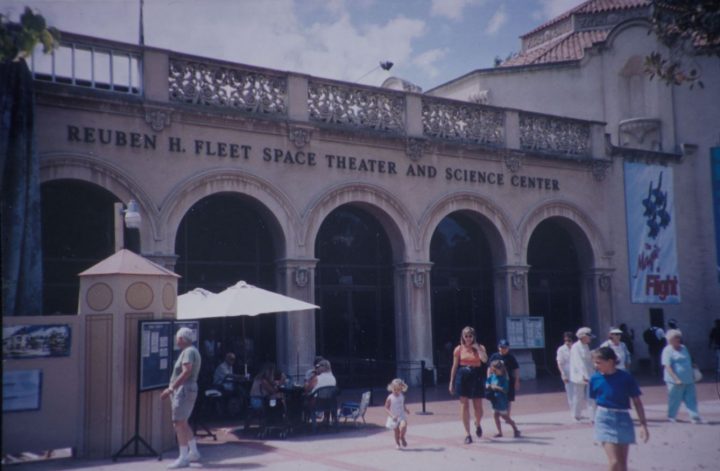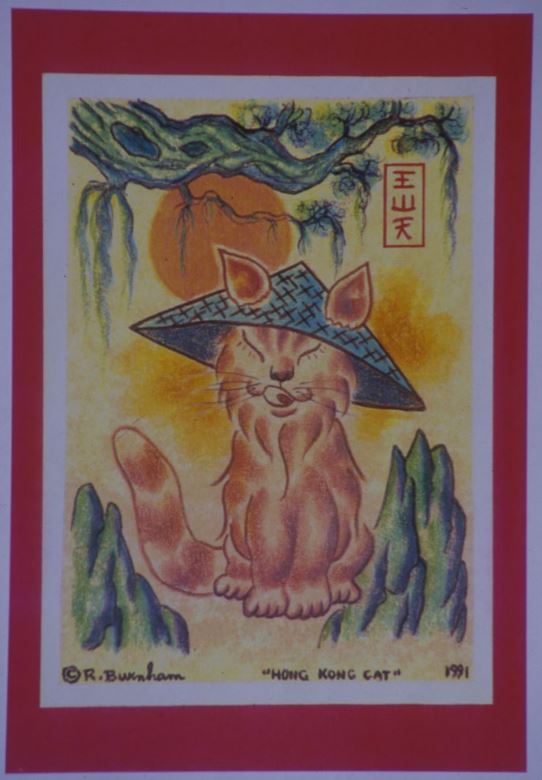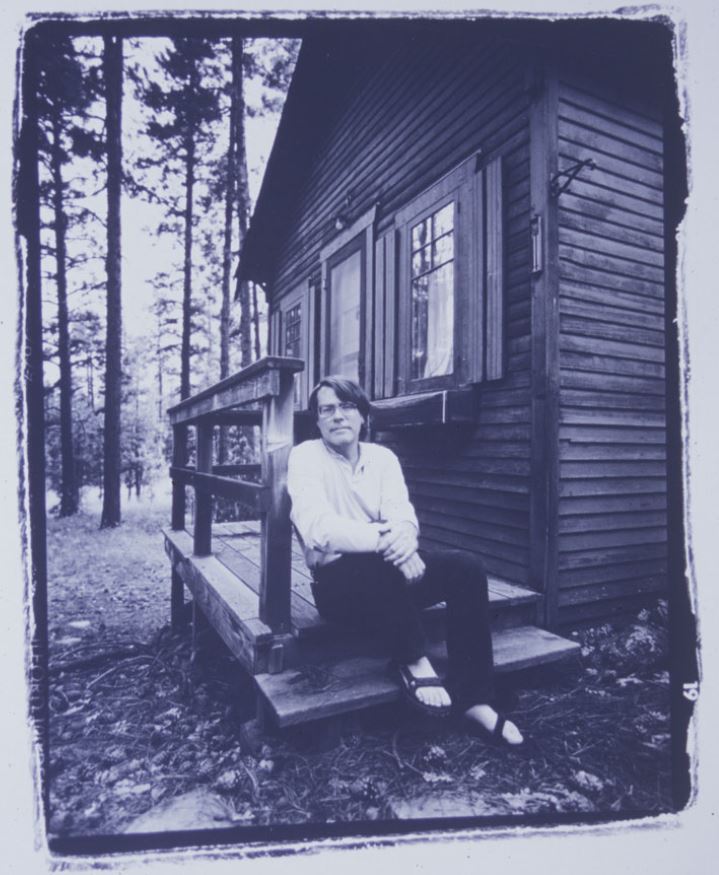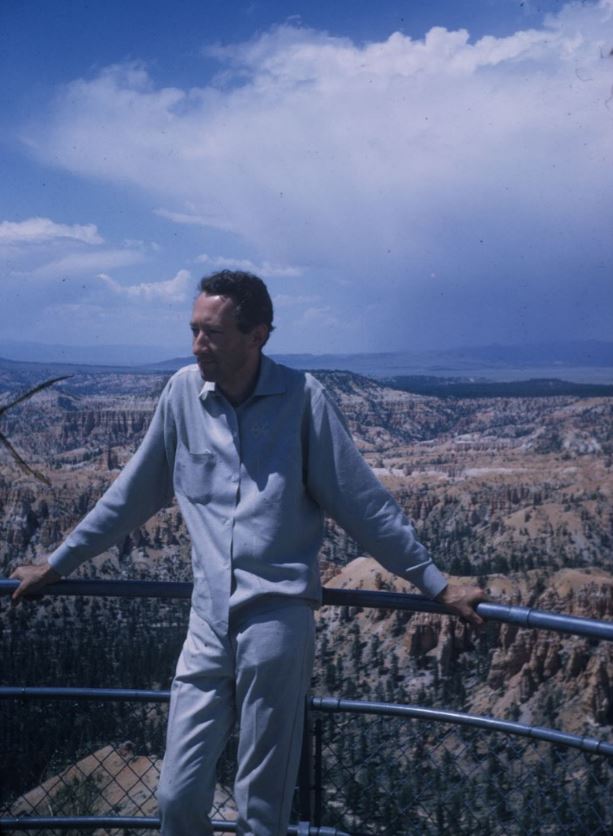By Tony Ortega
This story was originally published on September 25, 1997 in the Phoenix New Times, where today the article is presented without art and in a rather shabby state. We decided to find room for it here at our website where we primarily write breaking news about Scientology. There is nothing about Scientology in this story, only an earnest tale about a singular person whose books have touched many lives. — Ed.
The old man who sold paintings of cats in Balboa Park entered San Diego’s Mercy Hospital on March 9, 1993.
He was dying of congestive heart failure, the result of a heart attack that he’d suffered weeks earlier.
Although he was only 61, his years in the park had prematurely aged him. He wore a beard, and his skin was tanned by his exposure to the sun. He was thin.
He suffered from several ailments. A blood clot in his heart. Gangrene in one foot. Pneumonia in his lungs. For days he lingered, but doctors decided not to take the risk of operating on him.
At 6:03 p.m. on March 20, the man’s heart stopped beating.
Days later his body was sent to a military cemetery for cremation after a check on his social security number revealed that he had served in the Air Force. A marble headstone bearing his name was placed on a wall among the names of other cremated veterans at Point Loma’s Fort Rosecrans National Cemetery.
No one noticed that the name on the headstone was misspelled, the result of a clerical error on the man’s death certificate.
No one at the hospital or at the cemetery knew the man, and no family members attended the placement of his cenotaph.
He was just a weather-beaten, penniless man who sold paintings of cats in Balboa Park who had grown old and died.
Years before he was a destitute painter, Robert Burnham Jr. had inscribed the universe. Writer, astronomer, finder of comets and asteroids and collector of ancient artifacts, Burnham was a singular Arizonan.
He was a scientist whose work at Lowell Observatory in Flagstaff helped advance the understanding of the sun’s neighborhood in space.
He was an author whose name has become so familiar to some readers it has become a sort of shorthand, like Audubon to birders, Hoyle to card players, Webster to poor spellers, Robert to parliamentarians.
More than 30 years after its first publication, Burnham’s Celestial Handbook: An Observer’s Guide to the Universe Beyond the Solar System remains a sort of real-life hitchhiker’s guide to the galaxy, a compendium with something to say about nearly every cosmic destination worth visiting.
Part travel guide, part history text, part encyclopedia, it’s like a handheld natural-history museum of the universe. And for decades it’s held a grip on the imaginations of most people who ply the night skies with telescopes, people who yearn to travel in space and know that they can, any dark and clear night.
Reading Burnham’s massive, three-volume work is like reading the notes of an adventurer who has spent a lifetime studying the treasures of a lost civilization: Its 2,138 pages are loaded with tables of data, technical passages and illustrations interspersed with historical arcana and ancient poetry. And all of it is meant as an incentive for the reader to recover those treasures by merely looking upward.
It is rarely compared to other books because there simply is none other like it. No other popular work approaches its utility and completeness; few other scientific texts contain its sense of wonder and even spirituality.
Despite Burnham’s abiding fame among skywatchers, few people knew much about the man himself. Partly, that was because of confusion over another man with the same name. An editor at a science magazine, the other Robert Burnham published frequently during the same period that the Celestial Handbook gained popularity, causing readers to assume that the two were one and the same.
But Robert Burnham Jr. published almost nothing else besides his Handbook, and shunned publicity.
He led an extraordinary, but ultimately tragic, life. He also was a bundle of contradictions.
Burnham was a recluse, and yet he craved public recognition. He devoted years of labor to extraordinary, disciplined work, and yet he was incapable of staving off poverty. He was a brilliant writer who had an uncommon memory, yet words failed him in social situations.
He knew the night sky like few other people have, but was oblivious to earthly concerns.
He felt betrayed by his publisher and others who had benefited from his years of remarkable work, and he sank into depression and bitterness at the same time his reputation soared.
His books are revered by tens of thousands, yet he died alone and unnoticed.
And that’s apparently just what he wanted.
After vanishing from his Phoenix home in 1986, he resisted attempts by his family to communicate with him. His sister, Phoenix resident Viola Courtney, only learned of her brother’s death after he had been dead for two years, and it took her nearly a year longer to find out where he had died. She didn’t communicate the news of her brother’s death to the community of readers who know his name well.
She had little idea he was still so admired.
Astronomers across the country register shock that Burnham could have been dead so long without the knowledge of the scientific community.
For many of them, professional and amateur alike, Burnham’s books are among their most prized possessions.
The Celestial Handbook, Burnham’s legacy, began life as a project he meant only for himself, a young Prescott shipping clerk with only a high school education.
But one night in 1957, he made a discovery from the front porch of his parents’ house that would bring him to the attention of state media and Lowell Observatory’s astronomers.
It also piqued the interest of an ambitious Arizona senator with his eyes on the White House who made a point of visiting the clever young man a few weeks later.
That visit would help launch Burnham on a remarkable trajectory which would end, eventually, in penury and anonymity.
On the night of October 18, 1957, eager to use the newest of his telescopes despite its lack of a proper mount, the 26-year-old Burnham propped up its tube against the porch railings of his parents’ Prescott home.
As on other nights, he used the instrument to scrutinize tiny portions of the sky, doggedly searching for items to include in a massive survey of the heavens that he had taken upon himself.
And it’s likely that as Burnham slowly examined multiple-star systems in the constellation of Cetus the whale, inside the house his mother sat at her desk, writing letters. She was part of a dying breed: people who develop reputations for writing letters to newspapers. Lydia Burnham voraciously devoured papers and fired off missives about politics and religion — “She was a fanatical nonbeliever,” says her daughter Viola Courtney — which were regularly printed and won her an army of far-flung correspondents.
She had gained particular influence with the editors of her hometown paper, the Prescott Courier, and in the coming days, she would use it.
That night, at 10:30 p.m., Burnham’s telescope found a smudge of light where there was not supposed to be one.
It was a comet, a celestial interloper speeding past the Earth in one of the nearest approaches of a comet in 50 years.
Although it was his first such discovery, Burnham knew what to do: He made a phone call to Lowell Observatory and sent a telegram to Harvard University.
The astronomers at Lowell didn’t try to confirm Burnham’s find until the following night. But by then clouds had scudded in over Flagstaff and would remain the next night as well.
Instead, a Swiss observatory acting on the sighting of Paul Wild, a comet hunter in Bern who had spotted the object a few hours before Burnham, grabbed credit for confirming the existence of the object. Fortunately, because Burnham had sent a telegram to Harvard, where the world’s arbiters of astronomical discoveries were located, Burnham’s observation was credited as well.
Comet Latyshev-Wild-Burnham would eventually gain its third name when a delayed report from a Russian astronomer — who had actually beaten the other two — arrived weeks later.
Today, about 30 new comets are found each year, mostly by professionals in the course of their work. A handful, however, are snared by amateurs. While a few of those discoveries become news items — such as Phoenix resident Tom Bopp’s 1995 co-discovery of the spectacular Comet Hale-Bopp — most go unnoticed by the nonastronomical world. In the 1950s, fewer comets were found, and amateurs played a greater role in spotting them. But even then, most discoveries did not excite the media, especially for an object such as Burnham’s which could not be seen by the unaided eye.
Arizona newspapers, however, hailed Burnham as a hero.
Stories began appearing October 28 in the Arizona Republic and the Phoenix Gazette as well as the Courier, which treated Burnham as something of a celebrity. The paper would consult him in future stories on celestial events as Prescott’s home-grown astronomer. Partly, that treatment may have happened because of his mother’s relationship with the paper’s editors.
Another reason for the attention was surely Lowell Observatory’s promotion of the story. Perhaps embarrassed that his colleagues had not confirmed Burnham’s find themselves, Lowell’s Henry Giclas mailed a congratulatory but apologetic letter to the amateur on October 24. The observatory then notified the press.
American paranoia about Russian superiority may also have boosted coverage. At least one news story presented Burnham’s ingenuity as a sort of Yankee comeback to Sputnik, the Soviet satellite which was then orbiting the Earth and unsettling the stomachs of hawkish Cold Warriors.
Particularly, one of the most hawkish of all.
Senator Barry Goldwater descended on Burnham on November 7. Their meeting was taped by a local radio station and preserved in the Courier.
“The Senator was quite intrigued to learn that someone with a home-built telescope had beaten the professionals to a ‘major astronomical discovery,’ as he put it,” Burnham would write years later. “But he was really fascinated by my account of the optical test of my telescope mirror. Here I was, measuring the curve on a mirror to an accuracy of a few hundred-thousandths of an inch, with equipment made from an old tin can and a razor blade.”
Goldwater was genuinely intrigued by Burnham’s feat, but he couldn’t help but make political hay out of the encounter. His comments were dutifully reported the next day: “It is exciting that Burnham . . . could use the talent God gave him, and not depend on doles from the federal government to make such progress,” said the conservative icon.
The senator surprised Burnham by offering him a telescope owned by his late uncle, Morris Goldwater, who had once been Prescott’s mayor. It was a valuable refractor which the elder Goldwater had purchased in 1882.
Burnham gladly accepted, promising to refurbish the old instrument.
“If I find another comet, I will name it after you, Senator,” Burnham said, making a promise he couldn’t possibly keep.
Only three months later, Burnham found another comet with his homemade telescope.
It was not named Comet Goldwater.
The first comet discovered in 1958, it would, according to standard scientific protocol, carry the names of its discoverers. In this case, that was a single person.
It is known as Comet Burnham 1958a.
Burnham’s meeting with Goldwater is preserved in yellowing newspaper clippings assembled in a faded green photo album. Other pages commemorate five of Burnham’s six comet discoveries.
Burnham put the album together himself and annotated it. It’s now in the possession of Viola Courtney, his sister, who lives in north Phoenix.
She has many of Burnham’s things, and one by one she brings out the pieces of his life to share them.
She resembles him. The same narrow face, dark hair and thin build. She is 64.
The two of them were born in Chicago: He on June 16, 1931, she two years later. The Burnhams relocated to Prescott in 1940 out of concern for their mother’s health. Robert Sr., a General Electric employee, followed three years later after he found work at the Iron King mine.
Both of their parents were outgoing and gregarious, Courtney says, which always made her wonder where her brother obtained his introversion.
“At school, they nicknamed him ‘Professor,'” she says. (His family’s nickname for him, however, was “Cosmo.”) He excelled in class, but didn’t make friends easily. Mostly, the two of them kept to themselves. Courtney’s brother’s powerful imagination could keep her entertained for hours. “He and I were real close as kids. He drew up a scroll with magic islands when he was 11 and I was 9. ‘Where do you want to go today?’ he’d ask.”
As teens, Courtney says, the two drifted apart. She spent more time with friends, while Burnham became increasingly absorbed in myriad interests — astronomy, geology, music, ancient history and drawing among them.
“He had a couple of good friends, but otherwise he kept to himself,” she says.
He had constructed a laboratory where he kept his growing collections of coins and rocks and artifacts, and where he performed experiments.
By the time Burnham entered high school, astronomy had become his main interest. But he told his sister that he didn’t plan to make a profession of it.
“He didn’t want to do the math. He was an observer. He really didn’t want to go into all of the mechanics of it,” she says.
Consumed by interests but with no practical ambition, Burnham graduated from Prescott Senior High School in 1949 and retreated to his laboratory.
“Back then it wasn’t so automatic that you go to college. As for Robert, there wasn’t money for it, anyway,” Courtney says.
So, for a couple of years, he did nothing, which was fine with his father.
Robert Burnham Sr. preferred that his children stay in his house. Lydia, however, wanted her son to do something besides work on his hobbies. She pushed him to get a job.
“Who’s going to pay me for anything I can do?” Courtney remembers her brother saying.
The war in Korea would force him to act. Faced with being drafted, he enlisted in the Air Force in 1951. The airman first class became a radar technician, traveled to exotic locales like Saudi Arabia, and, after his four-year stint, returned to the laboratory attached to his parents’ house.
“He was given an honorable discharge and then came back to Prescott to go back to doing nothing,” Courtney says.
Until, that is, his mother heard about an opening for a shipping clerk at Thunderbird Fashions, a Western clothing manufacturer.
“They checked applicants for school records, so he got it hands down. He was their best shipping clerk, ever,” Courtney says. “It didn’t make sense. He was so capable. I told him he should have stayed in the military. It fit him because the military took care of the mundane decisions and allowed him free time to pursue his interests.”
But Burnham seemed content. His nowhere job kept his mother happy and put change in his pocket, and his nights were free for the passion that was taking up more and more of his time: his Celestial Survey, as he called it.
He had conceived of it shortly after he returned from his assignment in the Air Force. Using a small refractor telescope, he became frustrated that the star charts available at the time came with so little information about all the intriguing symbols dotting the maps.
Here were thousands of objects of interest in the sky — multiple star systems, stars that changed brightness, clusters of stars, nebulae and distant galaxies — and little information about any of them. So Burnham began making his own notes about them, organizing the notes by constellation and recording them in loose-leaf notebooks which grew and multiplied.
By the end of 1957, he was using a larger telescope of his own construction, he’d made news as the discoverer of a comet, and his survey had grown to fill six notebooks and 1,200 pages.
And that’s when, despite his prediction to his sister, he indeed became a professional astronomer.
Henry Giclas has seen many people come and go in the 56 years he’s been associated with Lowell Observatory. Yet the 87-year-old still goes to his office there every weekday, and it’s no trouble for him to remember the details of hiring Robert Burnham.
“Anybody that spends a lot of time out looking for comets, first of all he has to have a lot of patience, and he has to want to take the time to do it. And so I just figured that anyone who would spend that much time would make a pretty good observer for a routine job.”
An article without a byline which appeared February 3, 1958, in the Courier described how Burnham got the post: “H.L. Giclas, of the Lowell Observatory, passing through Prescott, took Burnham to lunch, and invited him to visit the Flagstaff observatory over the following weekend. Soon after he returned home, he received the offer of the position in the observatory. The camera studies he will make are expected to take a two year period, Burnham said. . . . He will begin his work on Feb. 10.”
Courtney remembers her mother telling Burnham: “If you turn this down, you’re crazy.”
“I’m not going to turn it down,” he answered.
He accepted the job at $6,000 a year with the likelihood that it would last only the two years of the project.
Then, Giclas says, the entire deal nearly fell through.
The February 3 Courier article infuriated the astronomers at Lowell. Always sensitive about Lowell’s reputation, they did not appreciate that Burnham had spoken about his upcoming job without the observatory’s approval.
“We had a bit of trouble about that article in the Courier. His mother, you know, was a kind of jackleg reporter for it,” Giclas says.
“He damned near didn’t get the job. We thought he’d written that article.” They changed their minds, says Giclas, after a contrite Burnham convinced them that he hadn’t written it.
“It was his mother. When I offered him that job, his mother went bonkers and wrote up a big story about how he was going to do a proper motion program at the Lowell Observatory when the guy didn’t even know what a proper motion was.”
It wasn’t the first time the observatory had hired a skilled amateur on the cheap for repetitive work that better-paid professionals might have scorned.
In 1929, a young Kansas farmer sent the observatory detailed drawings of Jupiter and Mars that he’d made with a homemade telescope. Lowell astronomers were sufficiently impressed that they hired the young man, named Clyde Tombaugh, to help with an ambitious, but tedious, project.
The search for Planet X.
The observatory’s founder, Percival Lowell, had predicted that a massive ninth planet might be found beyond Neptune. Lowell had died in 1916, but his colleagues were eager to validate his Planet X theory. It might help counter the observatory’s association with Lowell’s more well-known legacy, his infamous and illusory Martian “canals,” and rescue the observatory from a second-class status.
Fortunately, Tombaugh proved to be more than simply a hired hand. On February 18, 1930, Tombaugh brought glory to Lowell Observatory by discovering the only major planet found this century.
It was named Pluto. (But Lowell was not vindicated: Pluto was much too small to be his predicted Planet X.)
Now, in the late 1950s, with Tombaugh no longer associated with the observatory and his planet search long over, Henry Giclas had conceived of a way to make additional use of Tombaugh’s labors.
He would take a series of long-exposure photographs of the sky, each on a glass plate corresponding with one taken by Tombaugh 30 years earlier. In that time, some of the stars would show movement. The closer ones would, anyway, just as when motorists see objects that are closer whiz by faster than distant ones.
Identifying that movement — called “proper motion” — was the best way to determine which stars were closest to the sun, valuable data for scientists who wanted to know what kind of stars a typical portion of the galaxy — namely our own — contains.
Soon after the project got under way, Giclas learned about the Prescott amateur who had discovered a comet, and decided to hire him.
But only, Giclas says, after Burnham’s mother apologized to the observatory for writing the unsigned article in the Courier.
“I couldn’t hold it against Burnham,” he says.
In 1959, with the continuation of his graduate studies in astronomy jeopardized by a lack of funds, Norm Thomas packed up his family of four and left Berkeley, California, for a job at Lowell Observatory.
There he was paired with Robert Burnham Jr., who for the past year had been working on the proper-motion survey with astronomers Giclas and Charles Slaughter.
Day after day, Thomas tried to trip up his taciturn and brilliant partner.
Sometimes he succeeded. Other times, Burnham came out on top.
Their competition would produce the most widely cited proper-motion survey in history.
Now that the project was running smoothly, Giclas and Slaughter turned it over to the two young men who lacked advance degrees in the field.
Both Burnham and Thomas were told not to expect the survey to last longer than three years.
Instead, it would last another 20.
Mostly, that was because of how well Burnham and Thomas worked together. Their success impressed the National Science Foundation, which continued to fund the project.
“Henry [Giclas] was quite good, but he was a little impatient with it,” Thomas says, adding that because Giclas wasn’t a “blinker” by nature, he wasn’t taking the project to its full potential.
To explain what he means, Thomas descends into the basement of one of Lowell Observatory’s oldest buildings where thousands of glass plates in white envelopes line the walls of a cramped room.
Against one wall is a contraption called a “blink comparator.” The machine held two glass plates at a time, one dating from the 1930s search for Planet X, the other exposed by Burnham or Thomas themselves. Corresponding postage-stamp-size regions from each plate were projected onto a screen, first from one plate and then the other, back and forth, clickety clack, endlessly.
With the plates lined up correctly, the stars in each portion projected on the screen would hold still. Even in the 30 years between exposures, most stars seemed fixed in their positions and showed no movement. But occasionally, in a particular field on the plates, Burnham or Thomas would notice a star make a subtle leap.
Thomas shows how he would mark the star with a dab of India ink, hoping that Burnham had missed it. After Burnham, using another, fresh plate, had made his own search, the two of them would compare notes, tallying up the moving stars, particularly the ones that the other had missed.
“That did provide something fun. Who would miss something really neat. It was a competition,” he says.
By the time the program ended in 1979, they would identify 9,000 high-motion stars as well as several comets, 1,500 asteroids and 2,000 new white-dwarf suspects — degenerate stars with incredible densities — as well as thousands of variable stars which they simply had no time to study.
Thomas describes it as a merry-go-round of activities. While one of them blinked during the day, the other would expose new plates at the 13-inch Pluto discovery telescope at night. Plates had to be developed, leaping stars identified and tabulated, and finder charts had to be made for the high-motion stars and white dwarfs so other astronomers could recover them in the sky. Both of them were also expected to help out by giving tours to visitors.
Somehow, the two of them found time in that demanding schedule to spend occasional nights simply touring the night sky with a telescope. Thomas says those nights are among his fondest memories.
“Bob was great to be with. I’d be the student. The stuff he had in his memory was just amazing.”
Like others, Thomas describes Burnham as exceedingly shy and reclusive. Only a few times, in their close 20-year collaboration, did Burnham make the trip down from Mars Hill to spend an evening at the Thomas home.
Burnham himself lived in a cabin on the observatory’s property. He’d moved into the rent-free home in lieu of a raise after his first year of work, and turned the place into a virtual museum.
Viola Courtney’s daughter Donna made frequent trips from Prescott and later Phoenix to visit her uncle. Often she would find him sitting in a rocking chair on pine needles outside his cabin, enjoying silence.
Inside, the cabin was a fascinating clutter. There were rocks that glowed under ultraviolet light. Ancient coins and other artifacts of long-dead cultures. Fossils of trilobites and sharks’ teeth. And on nearly every wall, from floor to ceiling, books.
Donna says she was careful to travel alone to see him. With people he knew well, Burnham relaxed and could be quite talkative. If Donna brought someone her uncle didn’t know, he’d clam up.
Once, she made a boyfriend wait in the car for a half-hour while she spent time with Burnham.
Burnham overcame his shyness sufficiently to have several girlfriends during his Lowell years. Viola Courtney and Thomas remember one woman in particular who seemed to bring Burnham nearly to the point of sociability.
“I remember that she was blond and curvaceous,” says Courtney. “She had visited the observatory on a trip. He would give talks to the tourists, and she was impressed by him. She was so taken, he arranged for her to have a summer job.”
Thomas remembers that Burnham was similarly taken, and that one time the shy astronomer gushed: “We’re really together on our philosophy.” Burnham was so far gone, Thomas says, he didn’t mind being seen holding hands with the girl.
The curvaceous blond herself, now Professor Julie Lutz of Washington State University, says she had just graduated from San Diego State University and spent the summer of 1965 at Lowell Observatory as a 20-year-old intern before beginning graduate work at the University of Illinois.
“Bob was very, very, very shy. But he was fascinating. His place was filled with fascinating stuff,” she remembers. “He was a pleasant person, but, you know, he didn’t talk to too many people at Lowell.
“He was like Tutankhamen’s tomb. Once you got to know him, you opened a passageway and then a lot of treasures would appear.”
She laughs when she’s told of Burnham’s comment about his philosophical girlfriend.
“I am a big reader of books. At that time, I think I’d read a lot of philosophy and history. I was probably pretty intellectual for my age. He was probably impressed that he could talk to me.”
She lived in a cabin near Burnham’s, and remembers walking hand in hand through the woods with the astronomer.
“Yeah, and that was about it,” she says with a chuckle.
Their fling ended with the summer.
But by that year, 1965, Burnham’s true love — the Celestial Survey he’d started 10 years earlier — was finally near completion.
Donna Courtney remembers walking around and around a long table at Lowell Observatory which was covered with papers.
The year was 1966. She was only 6 years old, but like the rest of the family, as well as Norm Thomas and his children, she had been enlisted by her uncle to circle the table with pages in her hands.
Collating hundreds of copies of the first of what would be an eight-volume, 2,000-page book seemed like an eternal task, and sticks in the memory of everyone who helped.
Burnham had decided to publish his Celestial Handbook himself.
He would write later that the idea of self-publication had come to him gradually, particularly after he began working at Lowell Observatory.
His employment there gave him access to the mountains of information in Lowell’s library, as well as the images on the thousands of glass plates he worked with every day.
His survey quickly became more than simply the observational notes of an amateur astronomer. Burnham could now include more scientific depth and thousands of intriguing photographs. He also injected material related to his other interests, including photographs of ancient coins that carried astronomical themes, discourses on the lore of constellations, even thousand-year-old Chinese poetry about the sky.
He knew it was becoming a remarkable work.
He’d made inquiries to publishers, Thomas says, but he was most often met with an, “Are you kidding?”
“I tried a few of the larger astronomical publishers,” Burnham wrote later. “Some thought that there really wasn’t much of a demand for anything like that. Others said that there was no way to finance such a thing. One publisher said that they would have to hire someone full-time for a couple of years just to check and edit the material. That would be a requirement, they said, if they were to publish. At a cost which would make the project impossible, of course.”
Thomas says Burnham was also disappointed by Lowell Observatory’s official position regarding the Handbook.
Namely, that there would be no position.
“I think Bob was counting on some promotional help from Lowell on the books, but it never happened,” Thomas says. The other astronomers, Thomas says, were concerned about the effect it might have on the observatory’s reputation if the books were full of errors.
“I knew him a lot better. I knew how careful he was. Other people didn’t know that,” Thomas says.
Other Lowell astronomers were also apparently unaware that Burnham had sought outside assistance to check the accuracy of his data.
Giclas, however, saw the books as an irritation.
“The great problem I had with him was his handbooks. I offered to have the observatory personnel here check what he put into them, but he was reluctant and would not do that. And for that reason I told him he could not make it a Lowell Observatory publication,” Giclas says.
“We had a great English amateur that published books and stuff, but the stuff he had in it was wrong. His name was Patrick Moore. In later years, he learned enough to at least try to put the facts down straight. But Burnham quoted Moore as many times as he quoted Henry Norris Russell or some other famous astronomer, you know. And that was the trouble; Burnham didn’t know the difference between someone who knew something and someone who didn’t.”
After Burnham finished collating the loose-leaf, typescripted books, Giclas says he gave them a cursory look. “I pointed out several errors in them. He may have changed some. I don’t know whether he did or not.”
Thomas says Burnham resented his colleagues’ reaction. “They were afraid that it would be full of errors, and then it turned out to be better than 80 percent of the stuff [published about astronomy] that comes out. The good reviews quieted some people down. That, and the fact that it became quite famous because of the lack of errors.”
No review carried more weight than that in the June 1966 issue of Sky & Telescope, the field’s primary popular journal. The reviewer, Robert Neil Stewart, found himself referring to a recent French book with a narrower scope as the only thing he could compare to the Celestial Handbook. While somewhat guarded in his praise (he only had the first, 218-page volume), Stewart did seem impressed by the sheer size of the projected work: “Mr. Burnham’s manual promises to be about 10 times more inclusive than its strongest competitor.”
And it was in English, to boot. “The greatest merit of the Celestial Handbook is its up-to-date and detailed physical information. . . . I know of no other place where all this information can be so readily obtained.” Yet, as Stewart and later reviewers noted, the Handbook was much more than an assemblage of data. He complimented Burnham for his frequent essays and other written interludes.
Thirteen years later, the same magazine would review the books again, and this time the writer’s tone would be less restrained.
Burnham’s Celestial Handbook had become a classic.
By 1976, Burnham had secured a deal with Dover Publications, Inc., in New York to republish the Handbook in three paperback volumes. Two years later, the books appeared.
As Sky & Telescope’s second reviewer, Kenneth Hewitt-White, noted in 1979, wherever people dedicated to exploring the night sky gathered, they would solve riddles about what they saw with a simple question: “What does Burnham say about it?”
Owners of small telescopes found it difficult to go where Burnham had not gone before.
The Handbook could guide the enthusiast from his or her backyard to the far reaches of the galaxy, explaining such concepts as stellar evolution en route.
The Handbook looked different from other books, with its many hand-drawn diagrams and the typescript pages preserved from the self-published edition.
It also contained passages that were pleasantly out of place in a book of science, such as the following statement in a section on cosmology, which tries to explain what our universe is doing here:
“Oriental philosophers speak of the ‘Tao,’ the all-pervading intelligence of the Universe, never personified or regarded as a ‘being’ of any sort; such a concept seems vastly more appropriate to the Universe we actually live in than do the grossly anthropomorphic and marvelously tortuous theologies of Western thinkers.”
Burnham knew that such passages would draw scorn from astronomers who held more mechanistic views. He would write later that he expected to come in for criticism for including them. But he was determined, he wrote, to make the books more than a dry list of data.
Courtney, who is now executor of her brother’s estate, says that the 1966, loose-leaf Handbook edition had eventually paid for itself, but Burnham was happy to be done with publishing the thing on his own.
Burnham wrote in 1982, “The memory of those days still causes me to leap forth from my pillow with a loud cry. I have this nightmare, you see, where I’m trying to publish the Britannica from my kitchen table. . . .”
But even as he began to enjoy the benefits of wider publication — and regular royalty checks — Burnham learned that Lowell Observatory planned to fire him.
Norm Thomas says that by 1979, one of the proper-motion survey’s goals had been met: After photographing small patches of the sky year after year, they had eventually worked their way to the north celestial pole, near the star Polaris.
There was still some sky near the southern horizon that they hadn’t gotten to yet, Thomas says, but the National Science Foundation refused to fund the project for an additional three years.
Burnham and Thomas had blinked their last plate.
By that time, Thomas had completed a master’s degree in geology at Northern Arizona University, and it wasn’t difficult for the observatory to find other work for him studying asteroids. But Burnham, despite his almost 22 years of service, wasn’t so easy to reassign.
“The only thing the observatory could offer him would be, well, a janitor’s job or something where he was supervised. And he didn’t want that kind of a job, so that was that. That’s all that was left that he was capable of doing,” says Henry Giclas.
Norm Thomas’ son Bruce, who was in high school at the time and had become close to Burnham, says that Burnham’s decaying relationship with Giclas also played a part in that decision.
“There was a building resistance between Burnham and Lowell [Observatory], partly because they felt he was using their resources for his Handbook. As it became more popular and people talked about it, Henry Giclas got more standoffish about it. There was a big lack of communication about the use of Lowell’s resources. Perhaps if Bob had been a better communicator he could have convinced the observatory that it was a positive thing for it.
“As the years went on, he was fighting with Lowell. He wanted to add to the public tour. He wanted a sound system and a choreographed slide show. He wanted a gift shop. But Giclas and others felt that it was a research institute that didn’t need to give tours.”
Thomas says Burnham wanted to take on more of those responsibilities, and hoped that he could make it a full-time job.
“Burnham brought his own stereo system. He brought blinds for the rotunda so a slide show could be put on, all on his own time and money. He felt, as the years went on, that Lowell didn’t care about that. Yet, ironically, 10 years after he had left, they adopted all those ideas.”
In April 1979, Burnham received official notice that his employment would end. The observatory gave him plenty of time to prepare: His job would not end until December of that year, and Lowell offered help finding him further employment.
Norm Thomas was exasperated by Burnham’s refusal to prepare for his termination.
“For years I’d kind of dogged him about investing in some land, some cheap land around here. And he never would do it. . . .In 1979, when he knew he was going to lose his job, I told him, ‘You should start moving into something right now that would get you independent of rent.’ I recommended a mobile home.”
Thomas says Burnham did nothing, and in December 1979, he packed up his collections and books, rented a large apartment in Flagstaff, and severed his association with Lowell. Rent payments would soon stretch his resources despite the royalty checks he was receiving from Dover.
Giclas says that inability to plan characterized Burnham. “He was just that kind of a character. He didn’t seem to worry about anything. I don’t know what you can attribute it to.
“Burnham did a very good job when he was told exactly what to do and what to look for. That was great. When that ended, we just didn’t have any place for him. Which is sad.”
Only later would his colleagues and kin learn what a lifeline the observatory had been for him. Once it was cut, Robert Burnham Jr. would never be the same.
I’m sitting here as I have on countless nights before, using as a reference work your Celestial Handbook, and reflecting as always upon what a marvelous book it is. I cannot begin to tell you how much pleasure these volumes have brought me, not to mention their great value as sources of information. I should like, as a token of my appreciation, to send you a copy of the new edition of my book Galaxies. . . . I hope you’ll enjoy the book at least a fraction as much as I have yours.
–letter from Timothy Ferris,
dated February 6, 1982
Timothy Ferris, author of the 1981 National Book Award-nominated Galaxies and the 1989 Pulitzer Prize-nominated Coming of Age in the Milky Way, says that he’s used Robert Burnham’s books for decades, but, when he’s asked about them, realizes that he’s never talked to anybody about them.
Like others, Ferris professes an admiration for Burnham’s writing while knowing little about the man himself. He did, however, correspond briefly with Burnham in 1982.
“I remember his being a rather disillusioned man, primarily over his publisher’s handling of the book,” Ferris says. The Berkeley journalism professor emeritus also remembers Burnham’s anger over his firing.
“Lowell Observatory was famously broke, and a lot of astronomers were supporting themselves with real estate speculation. I guess from his perspective he had worked mightily and had not been rewarded accordingly.
“I can certainly vouch for the book; it’s a terrific book. His historical focus ensures the longevity of it. He had the good taste and judgment that sets this type of work apart from others in its field. He had the good judgment, for example, not to focus on flash-in-the-pan research that would go out of date quickly,” Ferris says.
As the ’80s progressed, Burnham’s books continued to gain popularity as his own fortunes began a steady nose dive.
Bruce Thomas remembers that Burnham was initially optimistic when he left the observatory. He received royalty checks in the mid-four figures every six months, he had begun another writing project — a fantasy novel — which was taking on epic proportions, and he’d rededicated himself to painting and other interests he’d put off.
But that optimism, Thomas says, didn’t mask his bitterness at Lowell’s termination of him.
Burnham also complained about how Dover Publications marketed the Handbook. Its audience was a narrow one, Burnham knew, but he told Thomas that readers were willing to pay more than the $8.95-per-volume cover price. He also believed that Dover was unnecessarily holding up a Japanese translation of the book — he knew that Japan, with its large astronomical community, could be a ripe market.
But the hardest hit for Burnham to take was the deep discounting of the Handbook in 1981. As incentive to join, the Astronomy Book Club began offering the complete set for only $2.95. Burnham told his sister that his royalties that year dropped “like a paralyzed buzzard.”
Other complaints, Thomas says, were less rational. One of Burnham’s gripes against Dover was its lack of interest in his fantasy novel.
Burnham also admitted to Thomas that Dover had made numerous advances on his royalties to help him out when money was short.
Oddly, Dover Publications spokeswoman Rosa Lopez declined to speak about Burnham or the history of the Handbook, asking that New Times submit a list of written questions. A list was sent, but Dover did not respond.
Bruce Thomas says he became increasingly concerned about the aging astronomer. Years earlier, when Burnham still lived and worked at Lowell, Bruce Thomas and other children of Lowell astronomers had made Burnham’s museumlike cabin something of a clubhouse. Thomas credits Burnham and his words of advice for improving his performance in school and his later success as a mathematics teacher.
But after 1980, Thomas says, their relationship was reversed, and he found himself handing out the advice. Although only a recent high school graduate, Thomas tried to help Burnham with practical matters that seemed to mystify him.
“I talked to him about getting unemployment. But he never did it. That would mean going to an office and dealing with people, and he had problems with that.”
Burnham’s shyness had become a pathology.
“When you first met Robert, you met a wall,” says Viola Courtney’s friend Michael Bartlett, who met Burnham at this time. “He made a poor first impression. He was very shy; he wouldn’t meet your eye. But once you broke that shell, the dike broke and out would come pouring the universe. It was a damned shame that he was crippled . . . by this personality defect which encapsulated this amazing person.”
Burnham yearned for the recognition that his books increasingly generated, but he could not bring himself to seek out the people who could give it to him.
He couldn’t even face an interviewer.
In 1982, with the popularity of the Handbook probably at its height, a lengthy article about Burnham — the only substantial biographical piece about him — appeared in Astronomy magazine.
Burnham had interviewed himself for the article.
Arrogant, weird and fascinating, a much longer version of the “interview” resides among Burnham’s papers. In the 37-page, single-spaced essay, Burnham delves deeply into his philosophical and political thought. He rails equally against what he sees as the foolishness of Western religions as well as the foolishness of a mechanistic view of existence. He also condemns a society that could not see the shortsightedness of fouling the environment in the name of progress.
These beliefs — an Eastern approach to nature and a disdain for organized religion and materialism — were long-held and characteristic of Burnham. Newer was the sense of frustration that the Handbook, considering its scope and popularity, reaped so little compared to books on astrology and other nonsense that commanded million-dollar advances.
Such frustrations about money, Bruce Thomas says, would increasingly consume Burnham.
Viola Courtney says, “He probably would have had opportunities for public speaking, but didn’t pursue it. He had a delightful sense of humor.” Although Burnham could hardly converse with someone he didn’t know well, he had, in 20 years of giving tours at Lowell, developed the ability to speak comfortably before a crowd. Courtney says she wondered why her brother couldn’t have found work at a planetarium or some other science-related facility where he could share his immense knowledge. But Burnham would shrug when she suggested it.
Michael Bartlett: “Everyone could see Robert’s potential except for Robert.”
Bruce Thomas: “He was a very different Bob than the one I had first met. The one who had been optimistic about creativity and the world.”
Burnham became obsessed with money-making schemes. Courtney says her brother lost money in at least one pyramid scheme during the early 1980s. He also tried several times to sell items door to door using a unique marketing technique: an army of children. Buying jewelry cheaply from mail-order houses, Burnham would enlist Thomas and other teens to sell the items for him. “He probably thought that if he used kids, they could sell it, because he was no salesman,” Thomas says.
Burnham also began selling off the collections of coins, meteorites, jade and other items that he’d spent years collecting. “He was a connoisseur. These were all very high-quality things,” Thomas says. He remembers one object in particular, a silver Greek coin stamped with an owl. It was the pride of his collection, Thomas says, but Burnham parted with it for $800 to pay for rent.
“He was getting very stressed and upset. He started to grasp at straws — he’d talk about treasure hunting,” Thomas says. What began as a diversion during his years at Lowell — hunting for reputed treasure with a metal detector — turned into a fetish as Burnham’s bank account dwindled.
“In some of the final years that I knew him, he would say things like, ‘If I get evicted, I don’t know what I’m going to do. Become a bum, I guess, and lose all of this stuff.’
“For a year, I gave him 20 dollars a week to help him with groceries,” Thomas says, and he knew that two other sons of Lowell astronomers gave Burnham money as well.
In December 1983, Burnham spotted a reference to himself in an issue of Sky & Telescope. Columnist George Lovi wished that more authors would show the dedication and drive of Burnham and several others. Burnham had to respond; his letter appeared five months later.
“Lovi . . . lamented the fact that so few people display the dedication needed to accomplish such a large project. This is hardly surprising when the rewards offered by our society can be so small.
“I have devoted over two decades of my life to astronomy, and my Celestial Handbook has been called a modern classic. I am the discoverer of six comets, not to mention thousands of new proper-motion stars, which my colleagues and I found during a 21-year proper-motion survey at Lowell Observatory. As a result of all these accomplishments, my income has rarely risen much above the poverty level. . . .”
If Burnham, who kept so assiduously to himself, was unsure what impact his books had had on others, he could have had no doubt after the responses to his letter began to arrive.
Wrote one devotee: “I am an extremely grateful and dedicated admirer of your Celestial Handbook, and when I saw your address in Sky & Telescope, I felt compelled to write my appreciation. . . .”
And from other letters: “Could you be so kind as to send me your autograph, perhaps with a short message if you could spare a few moments. I would always proudly keep it with the Handbook. . . .”
“I would like to offer a very large and heartfelt thank you for this wonderful set of handbooks. My dog-eared set is always with me when observing. . . .”
“The text is beautifully written and is almost as enjoyable as actual observation. As a chemist, I can think of no comparable work done or possible in my field. . . .”
“Your Celestial Handbook is considered the Bible among all of my associates. . . . My set holds a revered place in my library. . . .”
“I am on my second set of these books–the first set wore out from heavy use. In my library of over 1,200 books, this set is my most prized possession. . . .”
One writer, Louis Lyell of Jackson, Mississippi, wrote Burnham about an observatory he had helped build at a private school, and about the school’s need for an astronomy teacher. The job seemed custom-made for Burnham, who enjoyed talking to young people about science more than anything else.
Lyell says he never got a reply.
Instead, Burnham sank further into bitterness and obsession about money.
Then, in July 1985, he vanished.
Viola Courtney can’t be certain what day her brother disappeared. At the end of August, Norm Thomas called to tell her that police were conducting an investigation and had searched Burnham’s apartment.
Courtney and her family traveled to Flagstaff that weekend. In her brother’s mailbox, she found a letter she had sent to him on July 17, and judging from the pile of newspapers on Burnham’s porch, that’s about the time that he abandoned the place.
Norm Thomas and Courtney say it looked like the apartment had been robbed, but selectively. Missing were many small items that seemed valuable — shiny artifacts and coins, mostly.
Otherwise, the apartment was filled with the things that had always been there, as if Burnham had left suddenly.
Burnham’s landlord threatened to have the contents of the apartment auctioned unless Courtney paid his back rent. She did. And the rest of the weekend, Courtney and her daughter Donna and Michael Bartlett moved the collections and books to a storage unit.
“Robert had sold things, but there was still a lot of stuff in the apartment. Books, books and more books,” Courtney says.
“Huge books,” says her daughter.
“And rocks. Buckets and buckets of rocks,” Bartlett adds.
Then, they set out to find Burnham in Mexican Pocket.
It was a place, Courtney knew, between Flagstaff and Oak Creek Canyon where her brother searched for treasure. Perhaps he had gone there and something had happened, she reasoned.
Courtney and Bartlett went there but found nothing.
Then, just as they were about to leave, Courtney spotted Burnham’s VW bus among the trees.
It was locked, and the metal detector was inside. There was no trace of Burnham.
Flagstaff police searched the area in vain. Burnham became another name on a nationwide missing-persons list.
And the people who knew Burnham began to get used to the idea that he might be dead.
Then, about 11 p.m. on September 9, seven weeks after Burnham had disappeared, a Newport Beach, California, police officer noticed a disheveled man walking aimlessly on the beach.
He asked the man’s name. “Robert Burnham,” the man answered.
Burnham was wearing a long-sleeve shirt and pants, but his feet were bare, and they were covered with second-degree burns from exposure to the sun. He was taken to the hospital for treatment, then released to a shelter.
“He had a beard, he seemed tired. His feet were horrible. But it was him. He acted like he always had,” says his niece, Donna Courtney. She lived in San Bernardino at the time, and she retrieved him from the shelter. Then her mother drove out to bring him home to Phoenix.
She installed him in her one-bedroom mobile home in north Phoenix and nursed him. It took several weeks for his feet to heal.
She asked him what had happened in the seven weeks he had been missing.
His answer was so strange, she recorded her remembrance of it so she wouldn’t forget it.
He had gone to Mexican Pocket to look for treasure, and he had fallen asleep, Courtney says as she narrates the tape.
“Then he woke up. And he thought it was very early in the morning, the time of day when vision is very poor. He looked toward the place where he had left the van, and he saw two life-sized elephants, and some figures of people moving around the elephants. Then the elephants faded and he saw a woman carrying a child. And that figure faded and then he saw a cat, and he said to himself, ‘At least I know that cat is real.’ But as the cat came toward him, it sort of shimmered and just dissolved. Then, he said, everything went crazy.”
Burnham told her a tale of fragments of visions: his hand magically going through the door of a car; traveling on a city street in another van; in a hotel room high in the sky with a big window without glass; a tremendously loud sound that forced him toward the open window; someone saying, “Let’s go to the beach.”
But the moment he heard himself say his name to the Newport Beach police officer, Burnham felt normal. From that point on, he could account for his whereabouts.
“He had no memory how he came to Newport Beach, no idea of reality during the prior [seven]-week period. All he remembered were the hallucinations,” Courtney says.
No one remembers Burnham, who was 54 at the time of his disappearance, using illicit drugs of any kind. Bruce Thomas says Burnham often spoke against their use.
Says Michael Bartlett: “The job at Lowell was virtually the only job he ever had in his life. It took care of all of the mundane things in his life. Throughout that period he didn’t have to worry about the things he needed, and he had meager needs. . . . But when that job ended, it cut the legs out from under him. Then suddenly he needed to fend for himself.
“If he had some kind of mental breakdown, this is what precipitated it.”
Whatever had caused Burnham to lose a grip on reality seemed to have passed.
But Courtney says Burnham admitted to her that he feared ending up in a mental institution. It was the reason he refused her suggestion to seek an examination.
She had other suggestions as well. While she had come to Burnham’s aid without question, as the days wore on, her living situation became intolerable. Sharing her trailer with her brother gave her no privacy, and Burnham never left the house. She suggested he get a job, and she made that request stronger after his semiannual October royalty check arrived.
It was for only $300. Burnham had taken so many advances in the past, there was hardly anything left of his pay.
Burnham did some telemarketing from the trailer, but he hung his hopes on a check he’d been waiting years for: royalties on the Japanese edition of his Handbook, which had finally been published.
Burnham told Courtney that he expected a lucrative check in April 1986.
She says he counted on more than $10,000, a bonanza, considering his current living situation. Courtney, desperate for some privacy, bought a townhouse with Bartlett. She told Burnham he could stay in the trailer rent-free indefinitely as long as he paid utilities. She hoped it would be an incentive for him to find a steady job.
Burnham became convinced that the Japanese edition would finally change his fortunes.
Then, the check arrived. It was for $500.
It devastated him, Courtney says.
Courtney tried again to wake her brother up to financial reality. “I told him, ‘You can’t live on the royalties from Dover. You can’t live on the royalties of the Japanese book. In your mail-order schemes, you lost more than you’ve made. You need employment, then you can get an apartment and bring your things down from Flagstaff.'”
She shrugs. “Those were my plans for him. But he didn’t seem to have any plans of his own.”
Bartlett says, “At this point, he didn’t seem to have any zest for life left.”
“Perhaps he left Phoenix because he was afraid I would keep pushing to get him some kind of counseling,” Courtney says, and she appears to battle feelings of guilt.
Every weekend, Courtney would visit Burnham at the mobile home. But early in June, Burnham left without warning.
She would learn that on May 30, 1986, Burnham had withdrawn the last $20 from his bank account. He left with the money, the clothes on his back, and his social security card.
When she noticed that Burnham’s royalty checks stopped coming to the trailer, she asked a Dover employee if it was forwarding his checks. Yes, she was told. But Burnham had requested that Dover not divulge the address.
She never saw him again.
The old man who sold paintings of cats in San Diego’s Balboa Park would line up early on weekend mornings so that he could get a one-day vendor’s license before they ran out.
Then he would arrange his paintings on a bench and sit down amid them. He wasn’t much of a salesman. He didn’t hawk his wares. He simply waited for someone to come by and look at them.
During the week, he would simply sit on the bench, alone. Or he would paint his cats.
Workers at the nearby Reuben H. Fleet Space Theater remember him. Dennis Mammana, the planetarium’s astronomer, remembers seeing the man sitting on the same bench, day after day.
When he’s asked if he knew the man was the author of Burnham’s Celestial Handbook, Mammana replies:
“He couldn’t have been. Robert Burnham, the man who wrote the Celestial Handbook, was an editor at Astronomy magazine at the time.”
When Mammana’s told that he has made the common mistake of confusing the two writers — that there were in fact two Robert Burnhams, and the author of the Handbook had ended up sitting on a park bench outside his planetarium — Mammana sounds dismayed.
“Somebody had told me that he claimed to be Robert Burnham. This is just incredible. I’m sure no one believed him. I mean, you don’t expect that someone in that condition would be capable of producing such a work. The book is on every astronomer’s shelf.
“What a resource he could have been.”
Dave Amero remembers that Robert Burnham was a very nice man who lived down the hall from him at the Golden West Hotel, a residence hotel in downtown San Diego which, judging by the people lounging in the lobby, is inhabited primarily by older men with little income.
Amero and Dick Frishkoren are behind the hotel’s counter in the center of a large lobby which hints at a grandiose past long gone.
Frishkoren is a snappy dresser, and it’s difficult to believe he’s ever actually stayed in the place. Amero, on the other hand, has dull eyes and a simple but straightforward way of speaking, and it doesn’t seem surprising that he’s lived in the hotel for 28 years.
Both men remember Burnham staying at the hotel several years, and the dates 1986 to 1993 sound right.
“He said he was an author and that he was working on a new book. He said something about painting, and he spent a lot of time just sitting in the lobby,” Amero says. The hotel lies about a mile from Balboa Park.
Frishkoren estimates that in those years, Burnham would have paid about $200 per month to stay in the hotel.
Amero also remembers that Burnham seemed ill.
In the fall of 1991, Bruce Thomas had relocated to San Diego. One day, he took a walk in Balboa Park with two friends and found himself amid the weekend vendors. There were performers of various types. Tarot readings could be had cheaply. And a man sitting on a bench was selling paintings of cats.
He seemed familiar, Thomas thought as he walked past him. The beard threw him off, but then it came to him: It was Robert Burnham.
Thomas turned back to him.
“Bob?”
Burnham kept staring at the ground. Then, without looking up, he said: “Yeah, it’s me. Hi, Bruce.”
Thomas sat down with Burnham and introduced his friends, telling them that this was the man he mentioned so often.
“It was awkward. My friends sidled away while I talked to Bob for 10 minutes or so. He seemed uncomfortable. He said that he’d been in San Diego on and off for many years, and had liked it and decided to move there. He said he was just taking it easy and was still getting checks from Dover.”
Thomas bought a painting for $5.
When Thomas asked Burnham where he was staying, Burnham said he was living somewhere downtown that didn’t have a phone. Then he changed the subject.
Twice more Thomas sought out Burnham, visiting him in the park for brief conversations. He purchased three more paintings.
Then, a few days after Christmas, Norm Thomas visited his son, and the two of them went to the park to reunite the two old Lowell astronomers.
“It was hard to tell how Bob reacted to that. He was friendly and talked with Dad amicably. I could tell that he was forcing himself to be upbeat,” Bruce Thomas says.
“They chatted for a little, mostly about astronomy. Bob asked about Lowell.”
Norm Thomas told Burnham that he planned to name an asteroid after him. But there was a problem. An asteroid already carried the name Burnham, named after a turn-of-the-century astronomer of no relation. But Thomas remembered that Burnham had told him that in Germany, his father’s parents had gone by the name Bernheim. So that’s the name Thomas planned to use, to honor his longtime co-worker.
“Bob seemed happy about that,” Bruce Thomas says.
The three of them had their picture taken.
Norm Thomas describes it as a pleasant visit and nothing more. But his son says the encounter affected his father deeply. “I think he was probably very upset, but he doesn’t like to talk about it.”
Bruce Thomas would make several more visits to the park looking for Burnham.
Each time, he looked in vain.
In the summer of 1995, Donna Courtney’s husband, David Bastuk, came home with an assignment from school. He was taking a night course to learn to be a private investigator, and he was assigned the task of finding a missing person.
So Courtney suggested that he find her uncle. She supplied him with what she knew about him.
A few days later, Bastuk told her that he had done a search on Burnham’s social security number, and, according to a computer database, Burnham had died in 1993.
It would take Viola Courtney another nine months to learn that Burnham had died in San Diego’s Mercy Hospital. She was slowed by a misspelled death certificate; a clerk had typed “Burham.”
The certificate indicates that Burnham was suffering from a host of ailments, all probably related to the gradual deterioration of his heart. Dr. John Dodge, the physician listed on the certificate, agreed to discuss Burnham’s file, but then changed his mind.
There is no indication of how long Burnham had suffered before he entered the hospital on March 9, or what treatment he may have received before that time. Neither Dave Amero at Golden West Hotel nor Dennis Mammana at Reuben H. Fleet Space Theater remembers Burnham’s needing to be hospitalized.
The certificate’s error was preserved on a marble headstone placed on Fort Rosecrans National Cemetery’s columbarium, a wall covered with headstones in memory of servicemen and women who had been cremated.
Courtney requested a correction. Today, Burnham’s headstone reads correctly, but his name still appears as “Burham” in the cemetery’s index.
Above his name on the headstone is a cross, put there at the request of a San Diego County public administrator assigned to oversee Burnham’s cremation.
It seems inappropriate.
“No, I don’t think of the universe as some sort of ultimate monarchy being ruled by a cosmic king on a throne, handing out written directives to his subordinates like a commanding general,” Burnham wrote in 1982. “Is there any religion that invites doubt, skepticism, or a freely inquiring type of mind? The scientist is free to say to his colleagues: ‘Gentlemen, new findings have made it necessary to revise some of our ideas.’ Have you ever heard a minister make such an announcement to his flock?”
But Bruce Thomas cautions against making too much of the symbol on Burnham’s memorial. “I’m sure if you asked him, he would tell you he wouldn’t want any kind of headstone, that it was silly. And he probably wouldn’t care what you put on it.”
As she did while he was alive, Viola Courtney has seen to her brother’s needs. She is executor of his estate and has wrestled with Dover Publications. Only recently, she says, did the company pay for three years of royalties owed Burnham’s estate. She has waited more than a year for Dover to submit an accounting of the Handbook’s sales in the final eight years of Burnham’s life.
Going through her brother’s papers, she also found that he had never withdrawn money from a retirement plan.
“It appears that he had money he didn’t know he had,” Michael Bartlett says. “He needed to be taken care of. He was like a brain in a bottle.”
Thirty years after its first publication, the Handbook remains a popular work. But the ineluctable shift of the Earth’s axis in space has made the positional data in the book sorely out of date. Other material is well behind the latest scientific understanding.
A year ago, a talented astronomer who has worked both as an amateur and a professional began considering taking on the task of updating Burnham’s massive work.
His name is Brian Skiff, he works at Lowell Observatory, and he knows the night sky about as well as anyone in the world.
He says that before taking on the challenge of producing a new, improved Celestial Handbook, he decided he’d better take another look at the old one.
“I was amazed. I think it’s just fantastic,” he says.
It was also daunting. Skiff thought better of the idea, and has put the task aside, at least temporarily.
He has enough work to do investigating asteroids. And when he’s done with a night’s observing, he retires to his home: Burnham’s old cabin.
On a recent afternoon in Lowell’s library, he talks with Norm Thomas about the few times he met Burnham.
Thomas grins when Skiff says that the most important work ever done on the 13-inch Pluto telescope was the proper-motion survey.
“I like to hear that,” Thomas says.
Later, walking across the grounds of the century-old observatory, Thomas talks about the nights when a high-school-educated shipping clerk took him on journeys to distant celestial realms. And then, with characteristic restraint, he sums up his feelings about Robert Burnham Jr.
“He is an amazing person who I value my acquaintance with,” Thomas says.
The asteroid Bernheim is currently 260 million miles from Earth, moving slowly eastward in the constellation of Leo.





